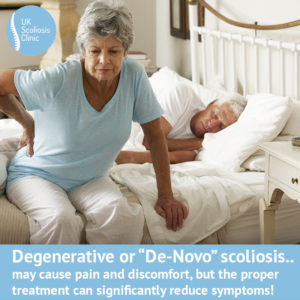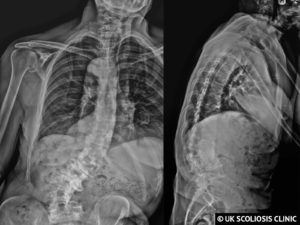Degenerative, or “De-novo” scoliosis is the name given to a scoliosis case which develops later in life and which has a known cause. Whereas the vast majority of scoliosis cases in younger people are classified as “idiopathic” scoliosis (that is to say, a condition without a clearly defined cause) de-novo scoliosis is understood to be the direct result of spinal degeneration – the term “de-novo” simply means “new”. Usually, de novo scoliosis develops as discs and facet joints (the hinge joints at the back of the spine) start to age – often in the lumbar spine (the lower part of the spine). When discs and facet joints age the vertebrae can slip out of place, which makes the spine curve – weakening of muscles and ligaments can also help to exacerbate the condition. Research suggests that de-novo scoliosis may affect as many as 30% of the over 60’s.[1]
Adult, or De-novo scoliosis?
Sometimes naming conventions are less than well thought through and scoliosis in adults is just such an example. There are, in fact, two main types of scoliosis in adults – these are de novo scoliosis and adult scoliosis. Adult scoliosis is the term which refers to a scoliosis case from adolescence, which has been carried into adulthood – and is also sometimes called adolescent scoliosis in adults (ASA). The difference matters since in adult scoliosis cases, curves that are 50 degrees or more in size after a person is fully grown are likely to increase by an average of 1 degree per year, whereas curves of less than 30 degrees rarely get significantly larger. De-novo scoliosis cases tend to increase in magnitude, but the progression is less predictable. Knowing as much as possible about a patients history is therefore critical to making the right diagnosis.
Is de-novo scoliosis painful?
There has been a long-running debate in the field of scoliosis treatment and research – does scoliosis cause pain? Since at least the 70’s there have been opposing views on both sides of the argument all of which have presented evidence to support their claims. In many instances, there have been limitations to the studies in both camps (with sample size being the most frequent issue) but it is also the case that adolescent scoliosis often receives more attention in research. In this regard, however, it does seem to be increasingly demonstrated that pain is correlated with scoliosis – and it’s not unreasonable to suggest the same is true in de-novo cases.
In the last 5 years or so, numerous studies have suggested that…
- Spinal pain is, in fact, a frequent condition in AIS patients, further supporting the need for early detection and screening to minimise potential pain and suffering[2]
- In patients under 21 treated for back pain, scoliosis was the most common underlying condition (1439/1953 patients)[3]
- In one study of 2400 patients with AIS, 23% reported back pain at their initial contact[4]
- Scoliosis patients have between a 3 and 5 fold increased risk of back pain in the upper and middle right part of the back[5]
- Chronic nonspecific back pain (CNSBP) is frequently associated with AIS, with a greater reported prevalence (59%) than seen in adolescents without scoliosis (33%)[6]
- Patients diagnosed with AIS at age 15 are 42% more likely to report back pain at age 18.[7]
In truth, whether or not scoliosis causes pain is less of an issue when it comes to adolescent scoliosis since most cases in young people are noticed either as a result of screening or due to visual symptoms. In adults, however, pain may well be a significant symptom which (since “back pain” is such a common condition today) many older people simply ignore.
Perhaps the link between de-novo scoliosis and pain was best summed up in a comment by Manuel Rigo, a scoliosis clinician with the Institut Elena Salvá in Barcelona, Spain, in a presentation to the 7th international conference on the conservative treatment of spinal deformities – according to Rigo (our emphasis added):
“Adult patients attending our institution – a scoliosis-specific rehabilitation centre – could be divided into two main groups: Group I: Patients attending the clinic with a clear self-conscience of belonging to the scoliosis population because they were mostly diagnosed during childhood or during adolescence – treated or not treated-; Group II: Patients belonging to the back pain population referred to us by their doctors, mostly because they showed a bad response to general rehabilitation and such a bad response was related to a non-previously diagnosed scoliosis condition. Generally speaking, we could identify patients with idiopathic, congenital and secondary scoliosis in Group I while most of the patients in Group II have developed de novo degenerative scoliosis or scoliosis secondary to any pelvic or lower limbs biomechanical disturbance.”
Therefore, while it is unclear exactly how well de-novo scoliosis and pain are correlated – pain is well worth considering as a possible symptom in older individuals. Indeed, many of our patients presenting with de-novo scoliosis do initially complain of pain. Indeed, the UK Scoliosis association now also recognises that patients with degenerative scoliosis will often also have back pain and muscle fatigue and that people with degenerative scoliosis sometimes also have back stiffness and leg symptoms, including pain, numbness, and weakness.
The positive message overall though, is that research does show that conservative approaches, such as part-time bracing can have a positive effect in reducing it where it does exist.[8] One such approach is our latest generation brace, the ScoliBrace. Unlike many scoliosis braces, ScoliBrace is a fully customised, 3D designed, CAD/CAM manufactured brace which is low profile, comfortable and easy to use, alongside specialist scoliosis exercises, part-time bracing with ScoliBrace can provide a significant improvement in quality of life for those suffering from De-novo scoliosis.
[1] ‘Scoliosis in adults aged forty years and older: prevalence and relationship to age, race, and gender‘
Kebaish KM, Neubauer PR, Voros GD, Khoshnevisan MA, Skolasky R, Spine 2011 Apr 20;36(9):731-6.
[2] ‘Back Pain and Adolescent Idiopathic Scoliosis: A Descriptive, Correlation Study’,
Theroux Jean, Le May Sylvie, Labelle Hubert [University of Montreal, Quebec, Canada; Murdoch University, Perth, WA, Australia], Spine Society of Australia 27th Annual Scientific Meeting (8-10 April 2016)
[3] Dimar 2nd JR, Glassman SD, Carreon LY. Juvenile degenerative disc disease: a report of 76 cases identified by magnetic resonance imaging. Spine J. 2007;7:332–7.
[4] Ramirez N, Johnston CE, Browne RH. The prevalence of back pain in children who have idiopathic scoliosis. J Bone Joint Surg Am. 1997;79:364–8
[5] Sato T, Hirano T, Ito T, Morita O, Kikuchi R, Endo N, et al. Back pain in adolescents with idiopathic scoliosis: epidemiological study for 43,630 pupils in Niigata City. Japan Eur Spine J. 2011;20:274–9
[6] Jean Theroux et al. Back Pain Prevalence Is Associated With Curve-type and Severity in Adolescents With Idiopathic Scoliosis Spine: August 1, 2017 – Volume 42 – Issue 15
[7] Clark EM, Tobias JH, Fairbank J. The impact of small spinal curves in adolescents that have not presented to secondary care: a population- based cohort study. Spine (Phila Pa 1976) 2016; 41:E611–7.
[8] Scoliosis bracing and exercise for pain management in adults—a case report Weiss et al, J Phys Ther Sci. 2016 Aug; 28(8): 2404–2407.



